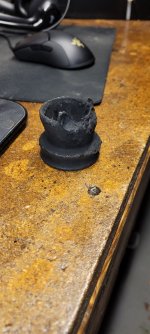You da man! No doubt about it. Have to say you've inspired me sir. Inspired me to be extremely careful when contemplating buying an older glass boat. So even though I may not ever go down your path, your experiences have been insightful and of great value. Something that would also be helfpul would be a guide to what to look for. Just how can one tell for sure a glass boat is solid or not? I mean other than your foot going through the floor......
Thank you sir,
Everything you described is what I was hoping someone would find useful from my journey.
The immediate visual signs would be any stress cracking of the gelcoat in the stern area, I had cracking between the sterndrive and drain plug on the exterior of the hull.
The other signs were after I started digging into her I found a stress crack in the gelcoat underneath the rear pad behind the doghouse, you wouldn't see this unless you folded it up . It ran across the top of the (above the cleat) stern and was about 10" long, I believe the stern was starting to completely separate from the hull due to rot and pulling a skier or maybe even just the torque, eventually there would have been a recovery if the boat was being used continually at that point.
The rot that I had shown in the beginning of my thread was obviously not visible till after demolition had started, but demonstrates what can be hidden under the glass.
As
@Scott Danforth usually tells anyone asking questions about a possible old boat purchase, tapping around with your hand or mallet on the hull or other areas will not tell you the real story you may be buying. (He usually is the first to respond to these questions)

If you purchase for $$$$ or free it will cost something no matter what, whether in structural rebuild, mechanical or both (I'm both) you need to realize that boats generally are not an item that one can flip for a profit like automobiles and if you start a build you need to like the boat and will it fit your needs because even if you would be fortunate enough to recoup your money invested by selling it the man hours (usually substantial) will never be.
If you like bringing things back from the dead these are good projects, but don't rush or be afraid to change timelines because they will change! (I was a year longer than planned).
I started rambling (sorry).
One things many of the long-timers here will say that to be as sure as you can be without demolition is doing bore tests on the transom and stringers if accessible.
Use a 1/4" drill bit to see what the shavings look like (light colored=good, dark colored=rot) then fill with 3M 5200, but most sellers won't allow a prospective buyer drill into their boat for some reason

.
Like you stated about soft spots in the floor and the cracks I mentioned the
@iboats is a great source of information for help and my story would have not ended as good as it did.
I ramble so if something is confusing please point it out


























